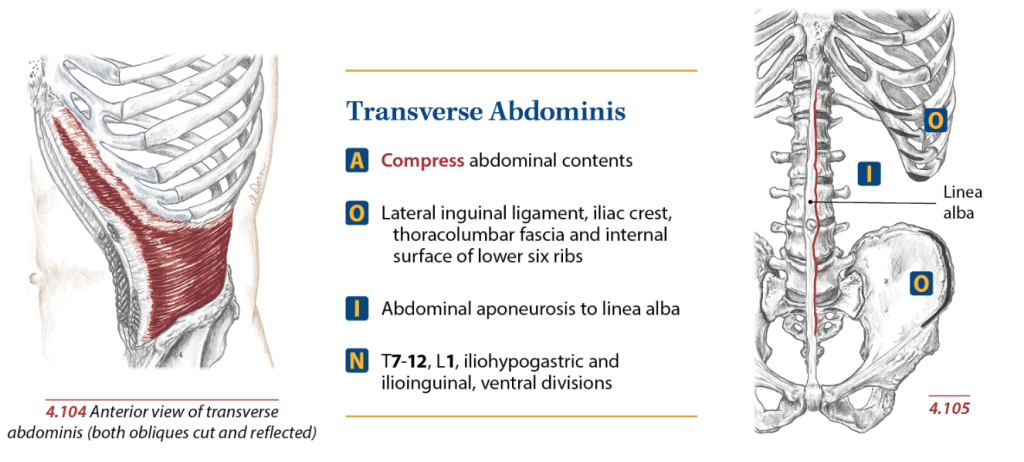When it comes to optimal personal training and fitness coaching, knowing the chief musculature of the human body is paramount. The transverse abdominis (TVA) wraps around your abdomen like a belt or corset. It has gained a lot of attention in the past decade. Understanding TVA in both contraction and relaxation as part of the larger core unit is crucial for performance and injury prevention.
Let’s take a closer look – this muscle is literally quite deep!
Transverse Abdominis Location
Use the images and instructions below to find the attachment points on yourself and connect to where transverse abdominis attaches. It might be easiest to locate when standing up or seated.

Books of Discovery 2014
Origin: Lateral inguinal ligament, iliac crest, thoracolumbar fascia (TLF), and internal surface of lower six ribs.
- Find the anterior hip bones at the ASIS – the inguinal ligament runs diagonally – inferior and medial from there.
- Follow the iliac crest posterior around the ridge.
- The TLF anchors the latissimus dorsi into the lumbar spine – palpate along the lateral spinous processes of the lumbar vertebrae on each side.
Insertion: Abdominal apeneurosis to linea alba.
- Follow the sternum down to the public bone – the linea alba is a band of connective tissue that separates the rectus abdominis and TVA into right and left sides.
- The abdominal aponeurosis is a sheath of fascia that covers the abdominal muscles.
Transverse Abdominis Action
- Compresses the abdomen and spine
- May assist in spine rotation
To explore the action of TVA inhale completely and exhale completely. On the exhale you can feel the compression of the TVA on the spine. Ease into the exhale so to feel when other expiration muscles contract with the TVA.
You might want the TVA to do most of the work without synergistic muscles supplementing OR you might want a team approach with multiple muscles. It all depends on the goal. It’s unrealistic to expect the TVA to contract completely independently but you can probably get it to come close.
Transverse Abdominis Exercises
Anytime a full exhale is utilized during exercise the TVA will contract. It will also contract when pressure is placed on the spine. This muscle can be called upon during most exercises when proper breathing is utilized.
- Stability Ball Crunches
- Plank – forearms or hands
- Side Plank
- Pulley Push Down
- Push Ups
These are just a few exercises TVA participates in. Anytime the core needs to be braced TVA is likely contracting. This is why it’s ideal to allow TVA relaxation time in between the work.
Transverse Abdominis Stretches
Stretching TVA isn’t so straightforward. To stretch the transverse abdominis, rotate the spine or side bend. A deep and full inhale may also stretch the TVA effectively. If there is pain when stretching –for you or clients– consult with a physician.
Transverse Abdominis Over-Training and Breathing
It is common for people to overwork transverse abdominis on a quest for six-pack abs. At the worst-case scenario, this can lead to a hernia or compression of the abdominal organs. Training all core muscles equally and allowing them as much relaxation as training is important to maintain healthy posture.
Reminding folks that it’s okay to relax the abdominal area and not look perfect all the time is part of a healthy body image conversation.
Transverse abdominis is a popular muscle to train. Identifying the attachments of origin and insertion and understanding its role within the core enhances body awareness, which can increase performance and decrease the risk of injury.
References
Abrahams, P.H. et al. 2003. McMinn’s Color Atlas of Human Anatomy. London: Elseiver.
Muscolino, Joseph E. 2004. Musculoskeletal Anatomy Coloring Book. Philadelphia, PA: Mosby, Inc.
Beverly Hosford, MA teaches anatomy and body awareness using a skeleton named Andy, balloons, play-doh, ribbons, guided visualizations, and corrective exercises. She is an instructor, author, and a business coach for fitness professionals. Learn how to help your clients sleep better with in Bev's NFPT Sleep Coach Program and dive deeper into anatomy in her NFPT Fundamentals of Anatomy Course.


